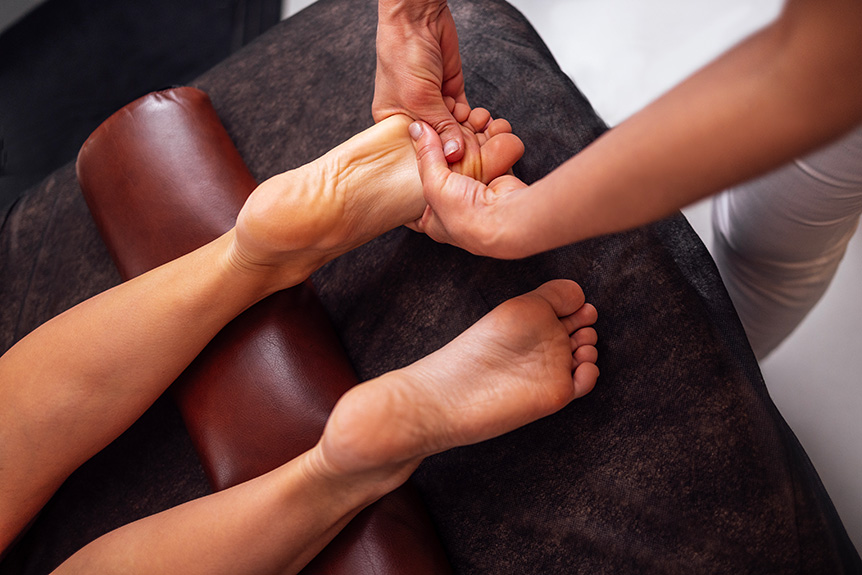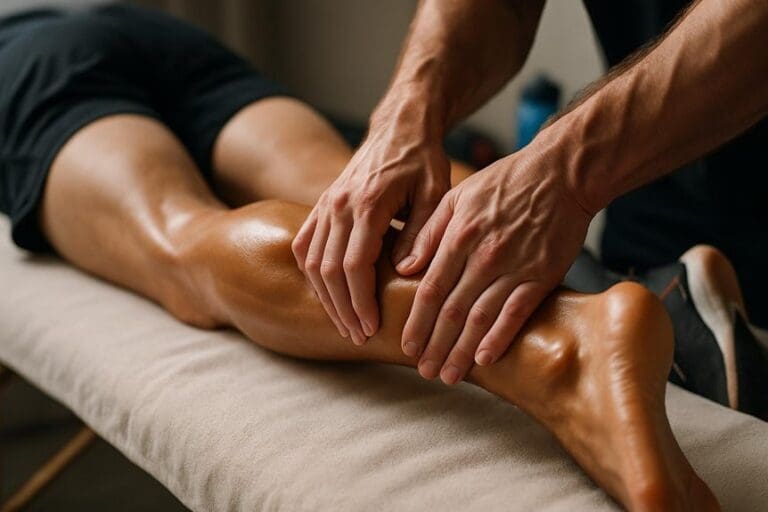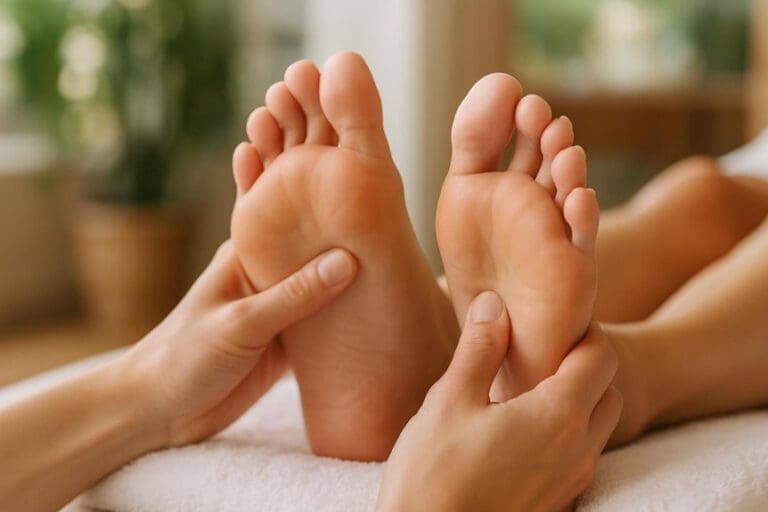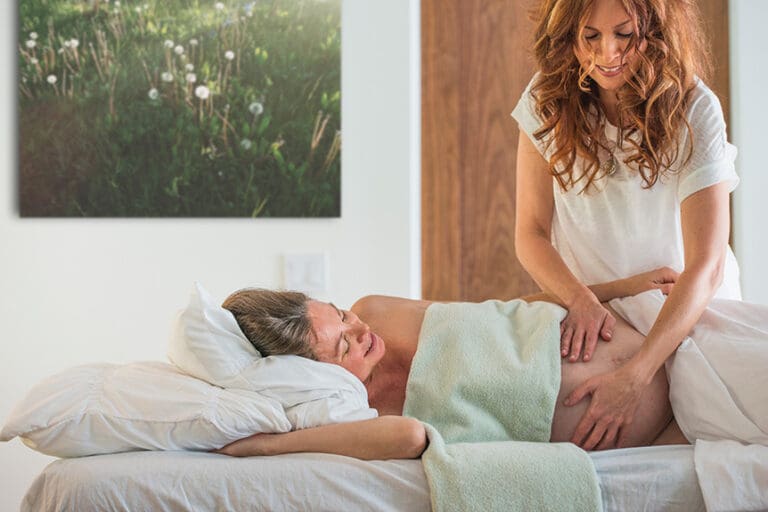It may modestly reduce headache intensity and frequency. Practitioners apply targeted pressure to foot, hand, and ear reflex maps to modulate autonomic tone, improve microcirculation, and dampen trigeminovascular and cervical nociceptive pathways. Key points include the great toe head–brain zone, brainstem-linked medial toes, neck/shoulder reflexes, solar plexus, and for migraines, sinus, pituitary, and liver–gallbladder zones. Evidence supports benefits for tension-type headaches and stress-related migraines when integrated with medical care. Further details outline mechanisms, techniques, and precautions.
What It Is and How It Relates to Headache Relief
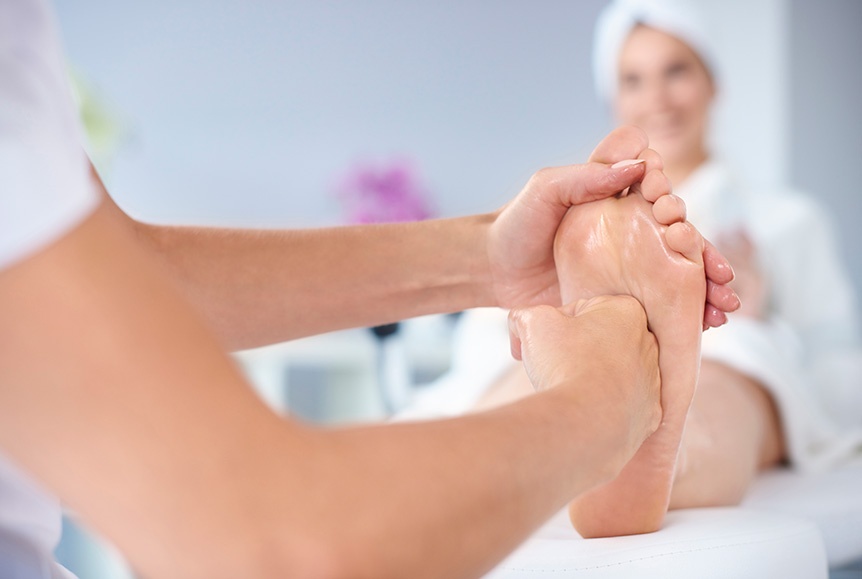
Although frequently described as a relaxation practice, this is a manual therapy that applies targeted pressure to defined reflex maps on the feet, hands, and ears, proposed to modulate autonomic tone, regional blood flow, and nociceptive processing.
From Spa & Massage’s perspective, its relevance to headaches lies in regulating sympathetic overactivity, easing myofascial guardedness, and improving microcirculation that influences trigeminovascular sensitivity.
By pacing pressure and breath, therapists aim to downshift hypothalamic–pituitary–adrenal arousal and reduce peripheral and central sensitisation that sustain head pain.
Clinical literature is mixed but signals reductions in perceived intensity and frequency when sessions are consistent.
In our London clinics, therapists tailor zone selection, pressure dosing, and session cadence to individual triggers, while monitoring response, hydration, and post-session recovery cues.
Reflexology is believed to support overall wellness by activating the body’s natural healing mechanisms through targeted pressure points on the feet, hands, and ears.
Key Reflex Points for Tension and Migraine Headaches
Building on the mechanisms outlined above, specific reflex areas are prioritised to target pathways implicated in tension-type and migraine headaches. The great toe (hallux) head–brain zone is used to modulate trigeminovascular irritability and cortical hyperexcitability.
Along the medial great toe, brainstem and cervical linkage points are engaged to influence nociceptive gating. For tension patterns, medial and lateral neck/shoulder reflexes below the fifth metatarsal address myofascial drive from upper trapezius and suboccipitals. The solar plexus point (central diaphragm line) is applied to downregulate sympathetic tone.
For migraine-prone clients, sinus reflexes at the toe pads, the pituitary point (centre of the great toe), and liver–gallbladder zones along the lateral plantar arch are prioritised to support vascular stability and hormone triggers. At Spa & Massage, therapists sequence these points gently, monitoring tenderness and neural quieting.
What to Expect in a Session at Spa & Massage
A massage session at Spa & Massage begins with a brief clinical intake to identify headache subtype, triggers, and contraindications (e.g., acute thrombosis, diabetic neuropathy, skin lesions).
The therapist maps symptoms to reflex zones—great toe (trigeminal and cervical modulation), medial arch (autonomic balance), and solar plexus point—then explains pressure dosing and expected sensations.
After warm cleansing, graded compression is applied to feet and hands, progressing from superficial fascia priming to targeted, slow holds.
Techniques aim to downshift sympathetic tone, ease pericranial muscle guarding via reflex arcs, and support microvascular regulation relevant to migraine and tension phenotypes.
Pressure is adjusted to tenderness; sharp pain is avoided.
Sessions last 30–45 minutes.
Post-session, hydration and quiet recovery are encouraged in-clinic or at home.
Evidence, Benefits, and When to Seek Medical Advice
Why consider this therapy for headache management? Evidence suggests modest benefits for tension-type headaches and stress-related migraine. Trials report reductions in pain intensity and attack frequency, likely via autonomic modulation: pressure to foot and hand reflex zones can downshift sympathetic tone, improve peripheral circulation, and reduce myofascial nociceptive input from the neck and temporalis.
This may ease central sensitisation and dampen trigeminovascular drive. At Spa & Massage, therapists apply structured, reproducible reflex maps and document outcomes to guide care.
Benefits may include shorter episodes, less medication use, and improved sleep—often when combined with medical plans. Seek medical advice urgently for “thunderclap” pain, new neurological deficits, fever, neck stiffness, head injury, cancer, pregnancy-associated headaches, or escalating frequency. Persistent migraine or refractory pain warrants GP or specialist review; it complements, not replaces, diagnosis.
Self-Care Tips and Aftercare Our Therapists Recommend
Following a massage session for headache relief, aftercare focuses on stabilising autonomic balance, reducing cervical and temporalis muscle nociception, and maintaining hydration to support neurovascular homeostasis.
At Spa & Massage, therapists recommend 500–700 ml water over two hours to optimise plasma volume and meningeal perfusion. Gentle cervical mobility (chin tucks, slow lateral flexion) reduces trigeminocervical convergence. Warmth across the suboccipitals or temporalis moderates myofascial tone; cold is reserved for pulsatile migraine flares.
Clients are advised to limit caffeine and alcohol for 12 hours to avoid autonomic volatility. Balanced meals with magnesium- and potassium-rich foods support membrane stability. Sleep regularity is prioritised.
Light walking enhances parasympathetic tone. For self-care between sessions, therapists teach precise thumb-walking on hallux and solar plexus reflexes, pausing with slow diaphragmatic breathing to extend analgesic carryover.
Conclusion
In the quiet cadence of this massage, headache relief is less thunderbolt than steady tide. By targeting reflex points linked to cervical musculature, trigeminovascular pathways, and autonomic tone, therapists aim to modulate nociception, ease myofascial tension, and optimize microcirculation. While evidence remains mixed and adjunctive, many clients report reduced allostatic load and calmer neural reactivity. As a complement—not a cure—it fits within a broader clinical mosaic: trigger management, hydration, sleep hygiene, and timely medical review when red flags surface.
